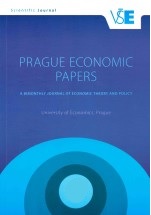Differences in Total Factor Productivity Growth in the European Union: The role of Human Capital by Income Level
Differences in Total Factor Productivity Growth in the European Union: The role of Human Capital by Income Level
Author(s): Sara Barcenilla, Gregorio Gimenez, Carmen López-PueyoSubject(s): Social Sciences, Economy
Published by: Vysoká škola ekonomická v Praze
Keywords: human capital; total factor productivity growth; technological diffusion
Summary/Abstract: This article applies Oaxaca-Blinder and Shorrocks-Shapley decomposition techniques to a logistic diffusion model in order to explain the differences in Total Factor Productivity Growth (TFPG) in European Union (EU) countries for the period 1950–2011. Human capital has a dual positive effect on TFPG by boosting innovation and increasing the catch-up capacity of countries to absorb and imitate foreign technologies. Our results show that there are statistically significant differences in the intensity of these effects between high and low average income EU countries, while there are not between euro and non-euro countries. The mean difference in technical change between high and low-income EU countries is largely the result of three factors. The first is the higher average foreign technology assimilation capacity of low income countries. This is particularly true because they are further from the technological frontier and are able to benefit from the advantage of backwardness. The second is the higher direct effect of human capital on technical change in these countries, while the third factor is the higher slowdown role of proximity in them.
Journal: Prague Economic Papers
- Issue Year: 28/2019
- Issue No: 1
- Page Range: 70-85
- Page Count: 16
- Language: English

